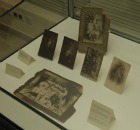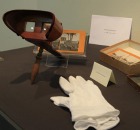The renowned singer and musician Na'ima al-Misriyya stands beside foreign travelers in their big hats and distinctive nineteenth century dress in the Center for Documentation of Culture and Natural Heritage's (CULTNAT) photographic exploration of Egypt's past.
Affiliated with the Bibliotheca Alexandrina and supported by the Ministry of Communications and Information Technology, CULTNAT’s mandate is to document and promote public awareness of Egypt's tangible and intangible cultural heritage as well as its natural heritage. Among its numerous projects is The Photographic Memory of Egypt (PME).
“Reading History, a Glimpse into Egypt’s photographic heritage is the name of the first exhibition,” explains Heba Farid, an independent artist and PME's program coordinator.
The PME’s primary activity is to digitize and document images of Egypt as well as important institutional and private collections from the nineteenth and early twentieth century.
The exhibition showcases much more than old authentic photographs. From the mere pauses, to the way they were dressed, down to the type of paper used in printing, the exhibition is indeed a stroll down memory lane.
The first exhibit presents Egypt from a foreign perspective. The sightseeing trips and the excavations of adventurous tourists are themselves a sight to behold. The images of tourists pausing in their flowing nineteenth century outfits, in front of ancient monuments, are prominent in the collection.
Fragments from the heart of Egypt’s collective memory are also displayed in the Na'ima al-Misriyya collection. Na'ima al-Misriyya (1894-1976), also known as Malikat Al-Istiwanat (Queen of the Gramophones), was one of Egypt’s most prominent chanteuses back in the early twentieth century. She was a key singer of Egypt’s music icon, Sayed Darwish, and later al-Misriyya’s singing career kicked off in 1911. She retired in 1937.
Glimpses of al-Masriyya’s life are revealed in her personal collection. Profile photos of her with the fashionable 1920s hats and loose outfits of the day have more stories to tell and memories to share.
“Na'ima al-Misriyya owned her own club," added Farida,Na'ima's great granddaughter.
It is interesting to note that she was among the very few women to do so. Only singers Fathia Ahmed and Munira El-Mahdia adopted the same line of thought in one way or another.
“In the early twentieth century, long before radio was invented, and predating the establishment of the music academy in the thirties, Na'ima was a pioneer in the realm of live performances in Egypt. Back then there were only two main streams of music: the private Salon music, or the Awalem (wedding bands); she was the transition from Awalem to professional singing,” explains Farid who is currently working on an independent project to document Na'ima al-Misriyya.
Among the most interesting items exhibited is the Stereoscope photography viewer. The wooden binoculars-like device uses various glass lenses that create a third dimension (3D) effect.
The 3D effect is created by having two similar images- (not identical- because they were taken by a twin-lens camera) placed in front of the eyes, which are then assimilated, forming one image. This is the natural mechanism of how we see. The lens on the stereoscope viewer magnify the effect.
Stereoscope photography was very popular in the early 20th century, as conveyed in James Henry Breasted's book "Egypt through the Stereoscope" (1905-1908), notes Farid. Slogans such as: People can travel to the Holy Land without moving' was printed on postcards back then,” she explained.
PME is one of many projects created by CULTNAT. However CULTNAT was first established in 2000. They started off with digitizing the Lehnert and Landrock (famous Swiss/German photographers who documented Egypt in the early twentieth century) collection in 2006. The outcome was a CD, produced with the consent of their families, of their renowned collection.
The current exhibition, according to Farid, is the first photographic one to be organised by PME. " We are now working in collaboration with the Folklore department initiative on Nubia documentation project," explained Farid adding that the Nubia collection includes photographer Abdel Fattah Eid – Nubian collection in partnership with AUC Rare books Library, as well as photographer Antoune Albert - Nubian Collection.
"As well as the nineteenth century travelers’ collection, in addition to the the Na'ima al-Misriyya collection, currently on display.”
The PME program is always looking for collaborations, whether private or institutional.
Reading History, a Glimpse into Egypt’s photographic heritage photo exhibition runs till Jan 22, 2011.
Daily from 9 am to 4 pm, except Fridays and Saturdays
 reading history2
reading history2 reading history 3
reading history 3Short link: